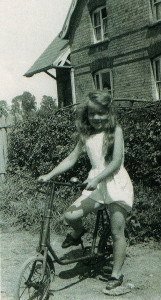
There’s a parcel on the bar,” mother would observe as we sat by the fire in the evenings. This would lead to some excitement and anticipation.
Our old kitchen range had four or five bars across the front to keep the coals in place. Paper thrown on the fire would sometimes leave a small charred piece, the size of a postage stamp, clinging to the bar.
Superstition had it that this was a sure sign we could expect to receive a parcel any day now. It was always my fervent hope that the parcel would be from my Aunt Lou in America.
Mother’s sister had lived in California for many years. Two or three times a year her daughter Margaret’s cast offs were sent to me. Times were hard in the 1930s and new clothes were practically unheard of in our house.
My Aunt Lou was an expert needlewoman and made all her daughter’s clothes.
Sixty years on, I can still remember some of them. There was the orange linen dress, beautifully embroidered with flowers and garden implements.
The yellow smocked one; the boldly printed linen coat (who wore a linen coat in England then?). And the frilly sunsuits, considered to be rather too daring to be worn on Sundays, but which I could show off on Saturdays and pretend that I, too, lived in Santa Barbara.
There was a beautifully-cut blue tunic with brass buttons down the side, worn over a blue and white silk dress which caused a neighbour to tell me I looked like
a queen. And white kid boots. They must have been the last word in grandeur but I wasn’t sure about them – I yearned for a pair of black patent ankle straps. But, oh, how I could lord it over my playmates. Who else had ‘clock socks’ with a design up the side? Who else had a pinafore in the shape
of a bewhiskered pink rabbit, whose ears formed shoulder straps? I even wore that pinafore to school when I was five.
Without doubt, my summer wardrobe was the envy of the class. Unfortunately it was never cold in California, so in winter I was much nearer the bottom of the ladder of elegance.
All through my childhood those parcels came, a Godsend to mother and me.
Then the war began and Aunt Lou sent food parcels. In them were strange concoctions we had never heard of -peanut butter and ‘Jello’. There were tins of Fifth Avenue coffee with labels depicting skyscrapers with a light in every window.
I could not begin to imagine how wonderful America must be, especially when mother described Aunt Lou’s iron which grew hot at the touch of a button and never left smuts on the shirts.
Silk stockings would arrive for mother; she hardly ever wore them, for she seldom attended a function which merited such luxury. There were dresses in fabrics we had never seen, perhaps the first of the synthetics.
The styles were always slightly outlandish and un-English but who were we to care? There was certainly nothing available in the tighdy rationed shops to compare with our finery.
Dear Aunt Lou, I don’t suppose she ever realised how much pleasure and excitement she gave us in those hard, hard years. I’m sorry I lost touch with my cousin Margaret – I’d still like to see ‘a parcel on the bar’,
Yvonne Penfold








